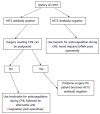Heparin induced thrombocytopenia in critically ill: Diagnostic dilemmas and management conundrums
- PMID: 26261772
- PMCID: PMC4524817
- DOI: 10.5492/wjccm.v4.i3.202
Heparin induced thrombocytopenia in critically ill: Diagnostic dilemmas and management conundrums
Abstract
Thrombocytopenia is often noted in critically ill patients. While there are many reasons for thrombocytopenia, the use of heparin and its derivatives is increasingly noted to be associated with thrombocytopenia. Heparin induced thrombocytopenia syndrome (HITS) is a distinct entity that is characterised by the occurrence of thrombocytopenia in conjunction with thrombotic manifestations after exposure to unfractionated heparin or low molecular weight heparin. HITS is an immunologic disorder mediated by antibodies to heparin-platelet factor 4 (PF4) complex. HITS is an uncommon cause of thrombocytopenia. Reported incidence of HITS in patients exposed to heparin varies from 0.2% to up to 5%. HITS is rare in ICU populations, with estimates varying from 0.39%-0.48%. It is a complex problem which may cause diagnostic dilemmas and management conundrum. The diagnosis of HITS centers around detection of antibodies against PF4-heparin complexes. Immunoassays performed by most pathology laboratories detect the presence of antibodies, but do not reveal whether the antibodies are pathological. Platelet activation assays demonstrate the presence of clinically relevant antibodies, but only a minority of laboratories conduct them. Several anticoagulants are used in management of HITS. In this review we discuss the incidence, pathogenesis, diagnosis and management of HITS.
Keywords: Critically ill; Diagnosis; Heparin; Management; Thrombocytopenia.
Figures



Similar articles
-
Screening frequency, incidence and pattern of heparin-induced thrombocytopenia syndrome at a large tertiary institution.Int J Hematol. 2016 Jul;104(1):92-8. doi: 10.1007/s12185-016-2013-3. Epub 2016 Apr 22. Int J Hematol. 2016. PMID: 27106479
-
Heparin-induced thrombocytopenia: frequency and pathogenesis.Pathophysiol Haemost Thromb. 2006;35(1-2):37-45. doi: 10.1159/000093542. Pathophysiol Haemost Thromb. 2006. PMID: 16855345 Review.
-
Testing for heparin-induced thrombocytopenia antibodies.Transfus Med Rev. 2006 Oct;20(4):259-72. doi: 10.1016/j.tmrv.2006.05.001. Transfus Med Rev. 2006. PMID: 17008164 Review.
-
Incidence and clinical significance of anti-PF4/heparin antibodies of the IgG, IgM, and IgA class in 755 consecutive patient samples referred for diagnostic testing for heparin-induced thrombocytopenia.Eur J Haematol. 2006 May;76(5):420-6. doi: 10.1111/j.1600-0609.2005.00621.x. Epub 2006 Feb 6. Eur J Haematol. 2006. PMID: 16466367
-
Contemporary standards for the diagnosis and treatment of heparin-induced thrombocytopenia (HIT).Surgery. 2008 Mar;143(3):305-12. doi: 10.1016/j.surg.2007.09.036. Epub 2007 Dec 21. Surgery. 2008. PMID: 18291250 Review.
Cited by
-
Heparin and Heparin-Derivatives in Post-Subarachnoid Hemorrhage Brain Injury: A Multimodal Therapy for a Multimodal Disease.Molecules. 2017 May 2;22(5):724. doi: 10.3390/molecules22050724. Molecules. 2017. PMID: 28468328 Free PMC article. Review.
-
The complicated relationships of heparin-induced thrombocytopenia and platelet factor 4 antibodies with COVID-19.Int J Lab Hematol. 2021 Aug;43(4):547-558. doi: 10.1111/ijlh.13582. Epub 2021 May 17. Int J Lab Hematol. 2021. PMID: 34000089 Free PMC article. Review.
-
Heparan sulfate/heparin glycosaminoglycan binding alters inhibitory profile and enhances anticoagulant function of conserved Amblyomma americanum tick saliva serpin 19.Insect Biochem Mol Biol. 2017 Jan;80:1-10. doi: 10.1016/j.ibmb.2016.11.002. Epub 2016 Nov 12. Insect Biochem Mol Biol. 2017. PMID: 27845251 Free PMC article.
-
Rivaroxaban improves patency and decreases inflammation in a mouse model of catheter thrombosis.Thromb Res. 2016 Aug;144:106-12. doi: 10.1016/j.thromres.2016.06.008. Epub 2016 Jun 9. Thromb Res. 2016. PMID: 27318247 Free PMC article.
-
Acute oxygenator failure: a new presentation of heparin-induced thrombocytopenia in a patient undergoing venovenous extracorporeal membrane oxygenation support.BMJ Case Rep. 2016 Dec 16;2016:bcr2016218179. doi: 10.1136/bcr-2016-218179. BMJ Case Rep. 2016. PMID: 27986695 Free PMC article.
References
-
- Howell W, Holt , E Two new factors in blood coagulation: heparin and pro-antithrombin. Am J Physiol. 1918;47:328–341.
-
- Crafoord C. Preliminary Report on post operative treatment with heparin as a preventative of thrombosis. Acta Chirurgica Scand. 1936;79:407–426.
-
- Weismann RE, Tobin RW. Arterial embolism occurring during systemic heparin therapy. AMA Arch Surg. 1958;76:219–225; discussion 225-227. - PubMed
-
- Roberts B, Rosato FE, Rosato EF. Heparin--a cause of arterial emboli? Surgery. 1964;55:803–808. - PubMed
-
- Natelson EA, Lynch EC, Alfrey CP, Gross JB. Heparin-induced thrombocytopenia. An unexpected response to treatment of consumption coagulopathy. Ann Intern Med. 1969;71:1121–1125. - PubMed
Publication types
LinkOut - more resources
Full Text Sources
Other Literature Sources
Miscellaneous

